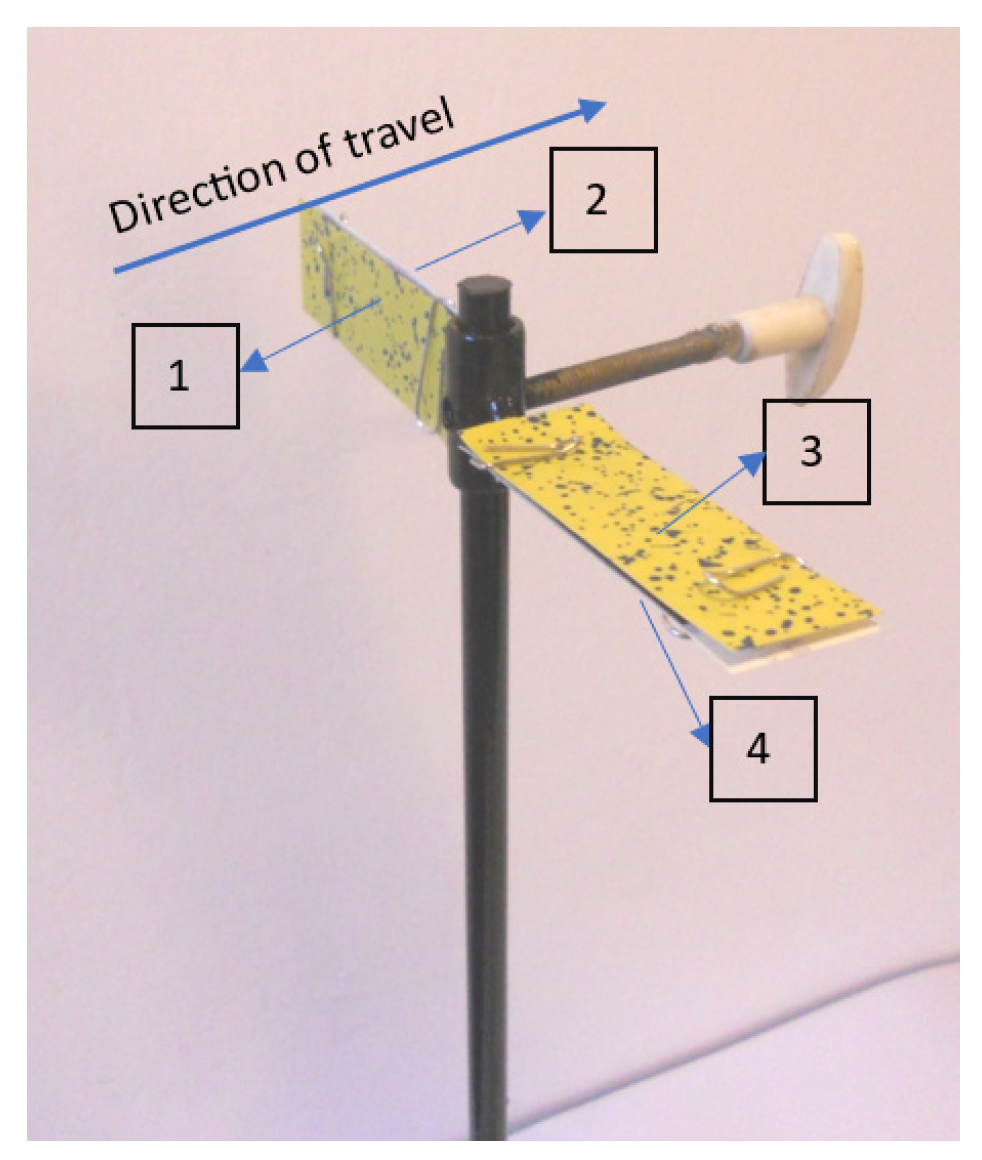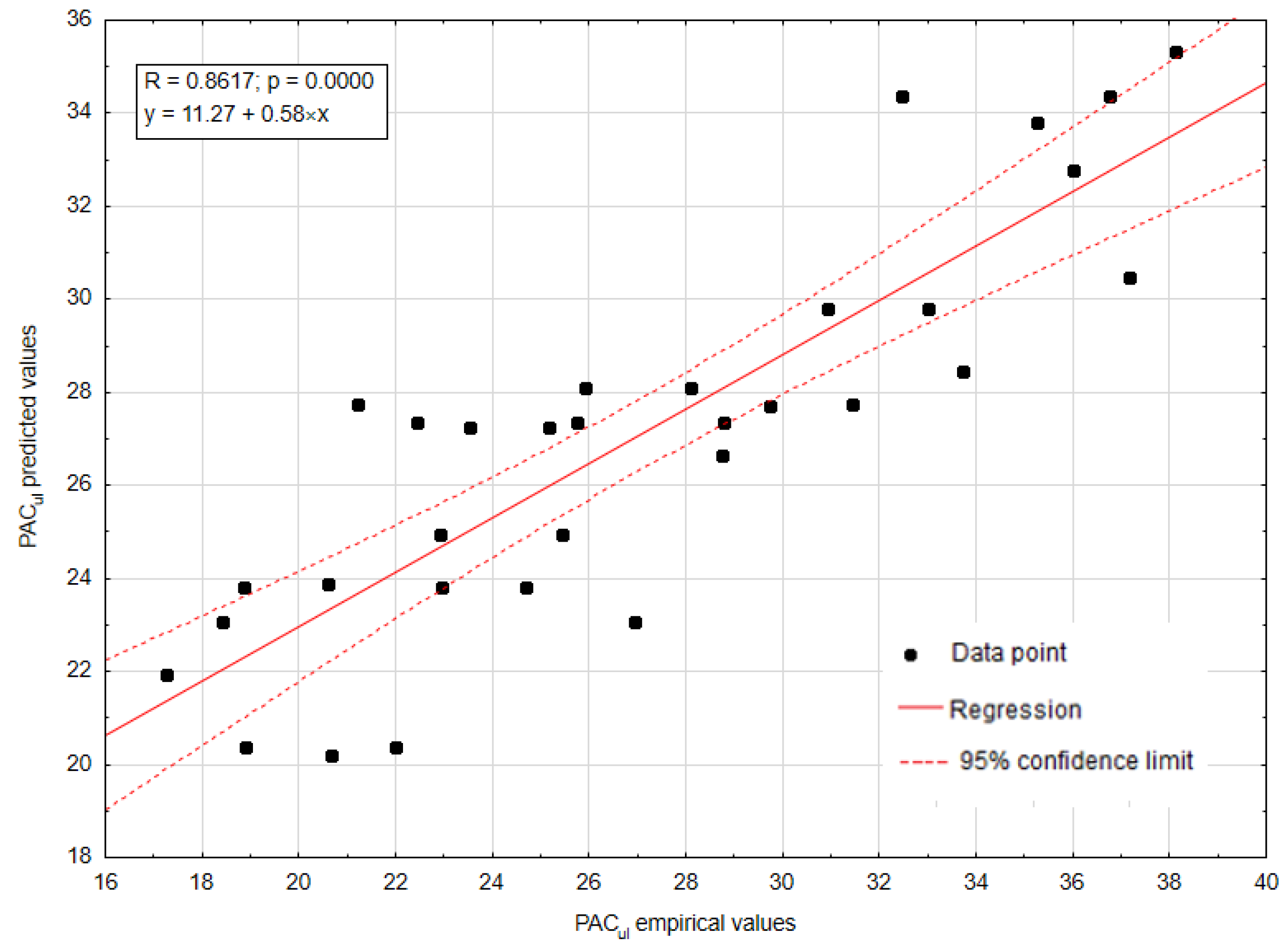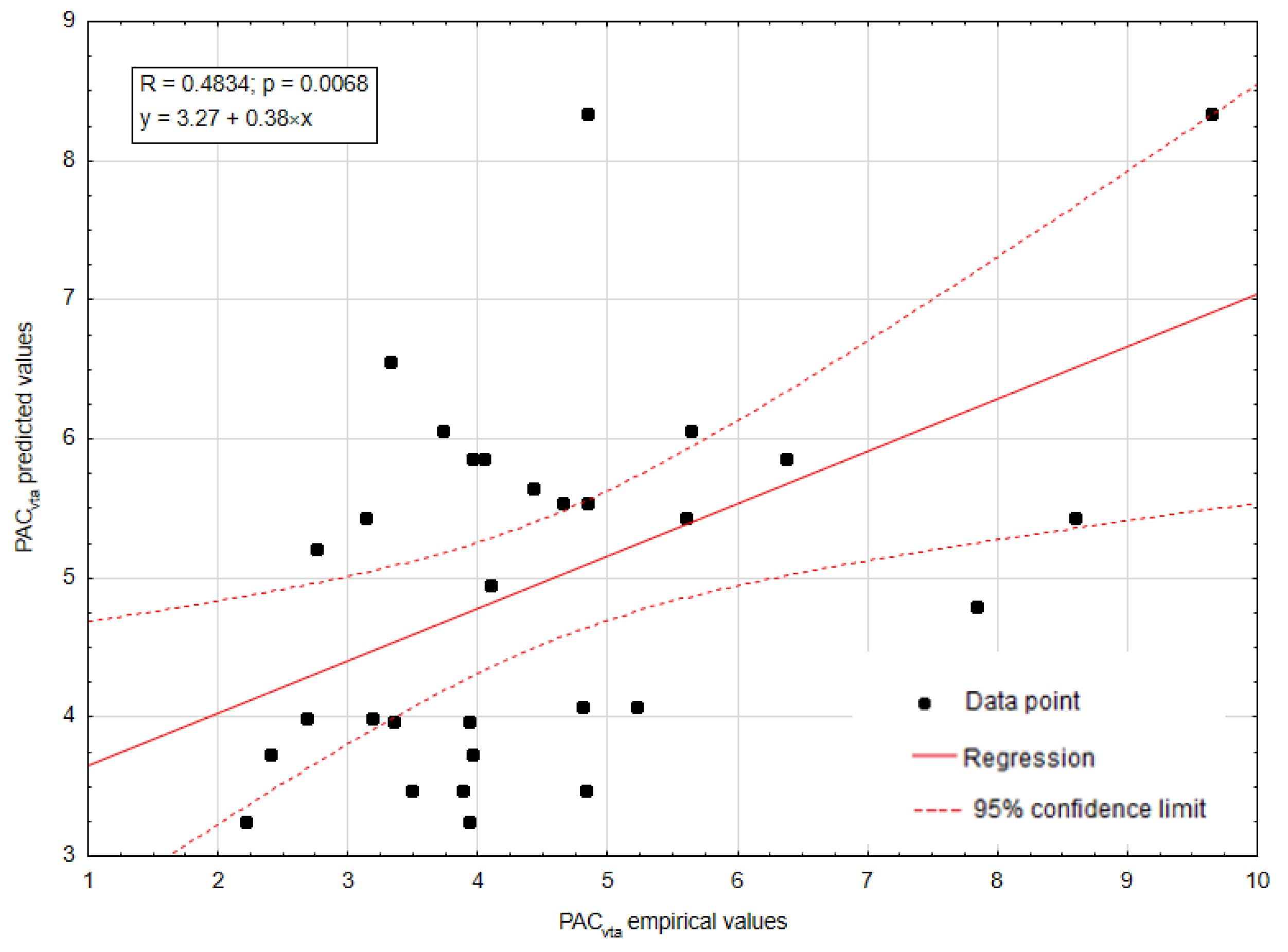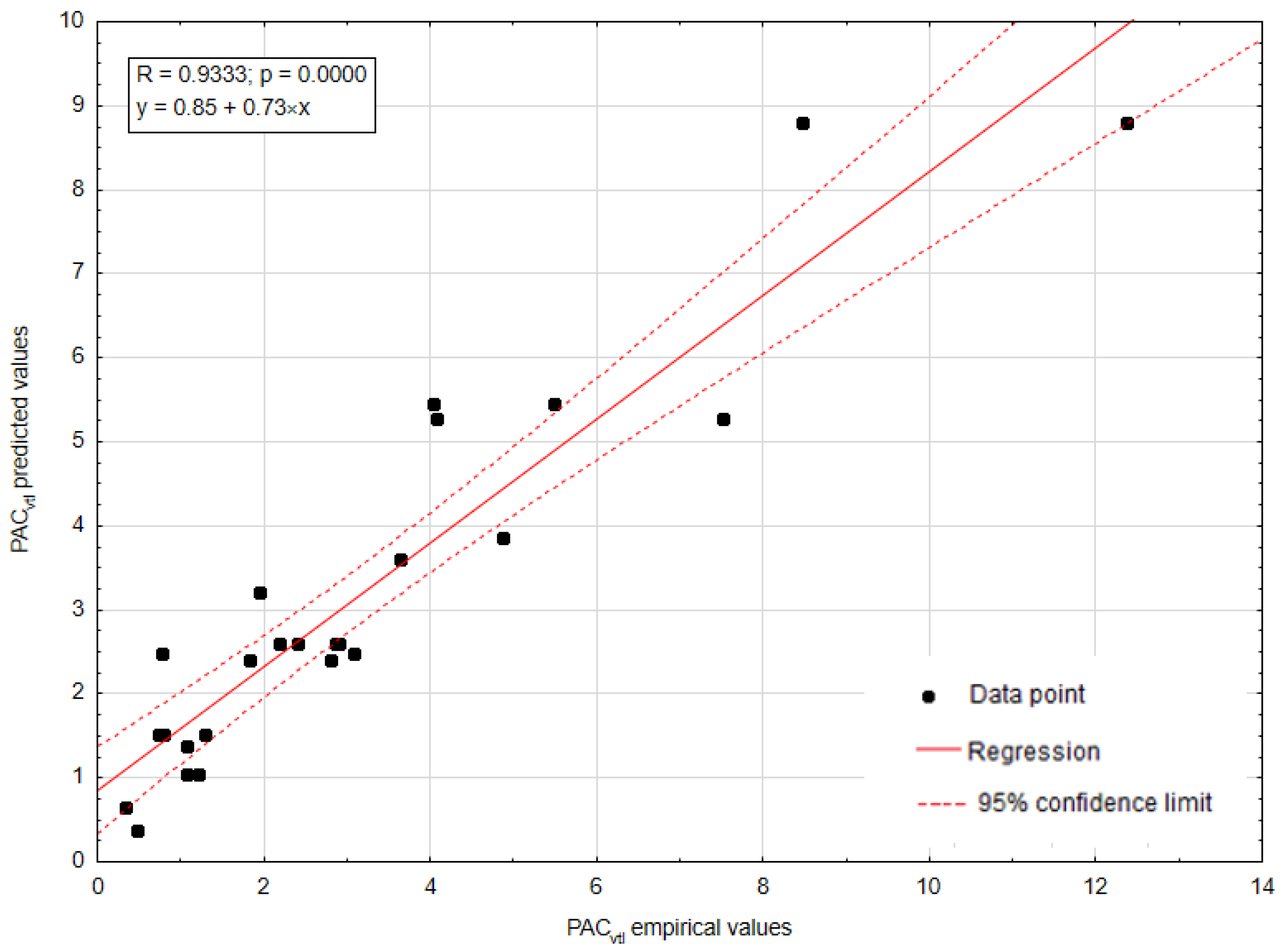Optimisation of the Spraying Process of Strawberries under Varying Operational Conditions
Abstract
1. Introduction
2. Materials and Methods
2.1. Experiment Set-Up
2.2. Artificial Neural Networks
2.3. Criteria of Accuracy Assessment of Models
2.4. Optimisation
3. Results
3.1. Artificial Neural Models
3.2. Sensitivity Analysis
3.3. Optimisation
- Scenario 2—minimum temperature and minimum wind speed,
- Scenario 3—minimum temperature and maximum wind speed,
- Scenario 4—maximum temperature and minimum wind speed,
- Scenario 5—maximum temperature and maximum wind speed.
4. Discussion
5. Conclusions
Author Contributions
Funding
Institutional Review Board Statement
Data Availability Statement
Conflicts of Interest
References
- Ministry of Agriculture. About Pesticides: Types, Names and Formulations; Ministry of Agriculture: Victoria, BC, Canada, 2017.
- EPA, South Australia. Safe and Effective Pesticide Use. A Handbook for Commercial Spray Operators. Available online: www.epa.sa.gov.au (accessed on 6 March 2024).
- OECD. Report on the State of the Knowledge—Literature Review on Unmanned Aerial Spray Systems in Agriculture; OECD Series on Pesticides; No. 105; OECD Publishing: Paris, France, 2021. [Google Scholar]
- Bessin, R. Kentucky Pesticide Education Program; University of Kentucky Department of Entomology: Lexington, KY, USA, 2016. [Google Scholar]
- Malik, R.K.; Pundir, A.; Dar, S.R.; Singh, S.K.; Gopal, R.; Shankar, P.R.; Singh, N.; Jat, M.L. Sprayers and Spraying Techniques—A Manual; CSISA: Dhaka, Bangladesh; IRRI: Los Baños, Philippines; CIMMYT: Texcoco, Mexico, 2012; 20p, Available online: https://repository.cimmyt.org/bitstream/handle/10883/1332/96765.pdf?sequence=1&isAllowed=y (accessed on 6 March 2024).
- Gil, E.; Arnó, J.; Llorens, J.; Sanz, R.; Llop, J.; Rosell-Polo, J.R.; Gallart, M.; Escolà, A. Advanced Technologies for the Improvement of Spray Application Techniques in Spanish Viticulture: An Overview. Sensors 2014, 14, 691–708. [Google Scholar] [CrossRef]
- Mattah, M.M.; Mattah, P.A.D.; Futagbi, G. Pesticide Application among Farmers in the Catchment of Ashaiman Irrigation Scheme of Ghana: Health Implications. J. Environ. Public Health 2015, 2015, 547272. [Google Scholar] [CrossRef]
- Ahmad, F.; Khaliq, A.; Qiu, B.; Sultan, M.; Ma, J. Advancements of Spraying Technology in Agriculture. In Technology in Agriculture; IntechOpen: London, UK, 2021. [Google Scholar] [CrossRef]
- Patel, M.K. Technological Improvements in Electrostatic Spraying and Its Impact to Agriculture during the Last Decade and Future Research Perspectives—A Review. Eng. Agric. Environ. Food 2016, 9, 92–100. [Google Scholar] [CrossRef]
- Abbas, I.; Liu, J.; Faheem, M.; Noor, R.S.; Shaikh, S.A.; Solangi, K.A.; Raza, S.M. Different Sensor Based Intelligent Spraying Systems in Agriculture. Sens. Actuators A Phys. 2020, 316, 112265. [Google Scholar] [CrossRef]
- United States EPA. Introduction to Pesticide Drift. 2022. Available online: https://www.epa.gov/reducing-pesticide-drift (accessed on 6 March 2024).
- Bartok, J.W., Jr. Sprayers and Spray Application Techniques, Center for Agriculture, Food, and the Environment. 2021. Available online: https://ag.umass.edu/greenhouse-floriculture (accessed on 6 March 2024).
- Damalas, C.A.; Eleftherohorinos, I.G. Pesticide Exposure, Safety Issues, and Risk Assessment Indicators. Int. J. Environ. Res. Public Health 2011, 8, 1402–1419. [Google Scholar] [CrossRef]
- Hanafi, A.; Hindy, M.; Ghani, S.A. Effect of Spray Application Techniques on Spray Deposits and Residues of Bifenthrin in Peas under Field Conditions. J. Pestic. Sci. 2016, 41, 49–54. [Google Scholar] [CrossRef] [PubMed]
- Kjær, C.; Bruus, M.; Bossi, R.; Løfstrøm, P.; Andersen, H.V.; Nuyttens, D.; Larsen, S.E. Pesticide Drift Deposition in Hedgerows from Multiple Spray Swaths. J. Pestic. Sci. 2014, 39, 14–21. [Google Scholar] [CrossRef]
- Nordgaard, A.; Correll, R. Sampling Strategies. In Integrated Analytical Approaches for Pesticide Management; Elsevier: Amsterdam, The Netherlands, 2018. [Google Scholar] [CrossRef]
- Teske, M.E.; Bird, S.L.; Esterly, D.M.; Curbishley, T.B.; Ray, S.L.; Perry, S.G. AgDRIFT®: A Model for Estimating near-Field Spray Drift from Aerial Applications. Environ. Toxicol. Chem. 2002, 21, 659–671. [Google Scholar] [CrossRef] [PubMed]
- Gu, C.; Zou, W.; Wang, X.; Chen, L.; Zhai, C. Wind Loss Model for the Thick Canopies of Orchard Trees Based on Accurate Variable Spraying. Front. Plant Sci. 2022, 13, 1010540. [Google Scholar] [CrossRef]
- Wang, M.; Rautmann, D. A Simple Probabilistic Estimation of Spray Drift—Factors Determining Spray Drift and Development of a Model. Environ. Toxicol. Chem. 2008, 27, 2617–2626. [Google Scholar] [CrossRef]
- Azizpanah, A.; Rajabipour, A.; Alimardani, R.; Kheiralipour, K.; Mohammadi, V. Precision Spray Modeling Using Image Processing and Artificial Neural Network. Agric. Eng. Int. CIGR J. 2015, 17, 65–74. [Google Scholar]
- Penaloza, E.A.G.; Mercaldi, H.V.; Oliveira, V.A.; Cruvinel, P.E. An Advanced Model Based on Analytical and Computational Procedures for the Evaluation of Spraying Processes in Agriculture. In Proceedings of the 2016 IEEE 10th International Conference on Semantic Computing, ICSC 2016, Laguna Hills, CA, USA, 4–6 February 2016. [Google Scholar] [CrossRef]
- Bird, S.L.; Perry, S.G.; Ray, S.L.; Teske, M.E. Evaluation of the AgDISP Aerial Spray Algorithms in the AgDRIFT Model. Environ. Toxicol. Chem. 2002, 21, 672–681. [Google Scholar] [CrossRef] [PubMed]
- Desmarteau, D.A.; Ritter, A.M.; Hendley, P.; Guevara, M.W. Impact of Wind Speed and Direction and Key Meteorological Parameters on Potential Pesticide Drift Mass Loadings from Sequential Aerial Applications. Integr. Environ. Assess. Manag. 2020, 16, 197–210. [Google Scholar] [CrossRef] [PubMed]
- Cieniawska, B.; Pentos, K. Average Degree of Coverage and Coverage Unevenness Coefficient as Parameters for Spraying Quality Assessment. Agriculture 2021, 11, 151. [Google Scholar] [CrossRef]
- Cieniawska, B.; Pentoś, K.; Łuczycka, D. Neural Modeling and Optimization of the Coverage of the Sprayed Surface. Bull. Pol. Acad. Sci. Tech. Sci. 2020, 68, 601–608. [Google Scholar] [CrossRef]
- Nadeem, M.; Diallo, C.; Nguyen-Quang, T.; Venkatadri, U.; Havard, P. Optimizing a Bi-Objective Mathematical Model for Minimizing Spraying Time and Drift Proportion. AgriEngineering 2019, 1, 418–433. [Google Scholar] [CrossRef]
- European Commission. Communication from the Commission to the European Parliament, the Council, the European Economic and Social Committee and the Committee of the Regions—A Farm to Fork Strategy for a Fair, Healthy and Environmentally-Friendly Food System COM, 2020, 381 Final. Available online: https://eur-lex.europa.eu/legal-content/EN/TXT/?uri=CELEX%3A52020DC0381 (accessed on 5 January 2024).
- Cieniawska, B.; Komarnicki, P.; Samelski, M.; Barć, M. Effect of Calcium Foliar Spray Technique on Mechanical Properties of Strawberries. Plants 2023, 12, 2390. [Google Scholar] [CrossRef] [PubMed]
- Kuźniar, P.; Pentoś, K.; Gorzelany, J. Evaluation of the Use of Machine Learning to Predict Selected Mechanical Properties of Red Currant Fruit (Ribes rubrum L.) Ozonized during Storage. Agriculture 2023, 13, 2125. [Google Scholar] [CrossRef]
- Pentoś, K.; Mbah, J.T.; Pieczarka, K.; Niedbała, G.; Wojciechowski, T. Evaluation of Multiple Linear Regression and Machine Learning Approaches to Predict Soil Compaction and Shear Stress Based on Electrical Parameters. Appl. Sci. 2022, 12, 8791. [Google Scholar] [CrossRef]
- Yoon, H.; Jun, S.C.; Hyun, Y.; Bae, G.O.; Lee, K.K. A Comparative Study of Artificial Neural Networks and Support Vector Machines for Predicting Groundwater Levels in a Coastal Aquifer. J. Hydrol. 2011, 396, 128–138. [Google Scholar] [CrossRef]
- El Bilali, A.; Moukhliss, M.; Taleb, A.; Nafii, A.; Alabjah, B.; Brouziyne, Y.; Mazigh, N.; Teznine, K.; Mhamed, M. Predicting Daily Pore Water Pressure in Embankment Dam: Empowering Machine Learning-Based Modeling. Environ. Sci. Pollut. Res. 2022, 29, 47382–47398. [Google Scholar] [CrossRef]
- Cieniawska, B.; Pentoś, K.; Szulc, T. Correlation and Regression Analysis of Spraying Process Quality Indicators. Appl. Sci. 2022, 12, 12034. [Google Scholar] [CrossRef]
- Dereń, K.; Cieniawska, B.; Szewczyk, A. The Average Coverage of Sprayed Objects Depending on the Coefficient of Spray Surface for the Selected Nozzles. Agric. Eng. 2016, 20, 31–41. [Google Scholar] [CrossRef]
- Sapkota, M.; Virk, S.; Rains, G. Spray Deposition and Quality Assessment at Varying Ground Speeds for an Agricultural Sprayer with and without a Rate Controller. AgriEngineering 2023, 5, 506–519. [Google Scholar] [CrossRef]
- Ferguson, J.C.; Hewitt, A.J.; O’Donnell, C.C.; Kruger, G.R. Comparison of Water-Sensitive Paper, Kromekote and Mylar Collectors for Droplet Deposition with a Visible Fluorescent Dye Solution. J. Plant Prot. Res. 2020, 60, 98–105. [Google Scholar] [CrossRef]
- Legleiter, T.R.; Johnson, W.G. Herbicide Coverage in Narrow Row Soybean as Influenced by Spray Nozzle Design and Carrier Volume. Crop Prot. 2016, 83, 1–8. [Google Scholar] [CrossRef]
- Ferguson, J.C.; Chechetto, R.G.; Hewitt, A.J.; Chauhan, B.S.; Adkins, S.W.; Kruger, G.R.; O’Donnell, C.C. Assessing the deposition and canopy penetration of nozzles with different spray qualities in an oat (Avena sativa L.) canopy. Crop Prot. 2016, 81, 14–19. [Google Scholar] [CrossRef]
- Creech Cody, F.; Henry, R.S.; Hewitt, A.J.; Kruger, G.R. Herbicide spray penetration into corn and soybean canopies using air-induction nozzles and a drift control adjuvant. Weed Technol. 2018, 32, 72–79. [Google Scholar] [CrossRef]
- Bahrouni, H.; Chaabane, H.; Marzougui, N.; Ben Meriem, S.; Bchini, H.; Ben Abdallah, M.A. Effect of Sprayer Parameters and Wind Speed on Spray Retention and Soil Deposits of Pesticides: Case of Artichoke Cultivar. Plant Prot. Sci. 2021, 57, 333–343. [Google Scholar] [CrossRef]
- Creech, C.F.; Henry, R.S.; Fritz, B.K.; Kruger, G.R. Influence of Herbicide Active Ingredient, Nozzle Type, Orifice Size, Spray Pressure, and Carrier Volume Rate on Spray Droplet Size Characteristics. Weed Technol. 2015, 29, 298–310. [Google Scholar] [CrossRef]
- Allagui, A.; Bahrouni, H.; M’Sadak, Y. Deposition of Pesticide to the Soil and Plant Retention During Crop Spraying: The Art State. J. Agric. Sci. 2018, 10, 104–115. [Google Scholar] [CrossRef]
- Virk, S.S.; Prostko, E.P.; Kemerait, R.C.; Abney, M.R.; Rains, G.C.; Powell, C.T.; Carlson, D.S.; Jacobs, J.L.; Tyson, W.G. On-Farm Evaluation of Nozzle Types for Peanut Pest Management Using Commercial Sprayers. Peanut Sci. 2021, 48, 87–96. [Google Scholar] [CrossRef]
- Liu, X.; Liu, X.; Li, Y.; Yuan, J.; Li, H. Predicting Spray Deposit Distribution within a Cotton Plant Canopy Based on Canopy Stratification Porosity and Gaussian Process Models. Biosyst. Eng. 2021, 204, 1–14. [Google Scholar] [CrossRef]
- Jiang, S.; Yang, S.; Xu, J.; Li, W.; Zheng, Y.; Liu, X.; Tan, Y. Wind Field and Droplet Coverage Characteristics of Air-Assisted Sprayer in Mango-Tree Canopies. Pest Manag. Sci. 2022, 78, 4892–4904. [Google Scholar] [CrossRef]
- Li, Y.; Yuan, J.; Liu, X.; Niu, Z.; Chen, B.; Liu, X. Spraying Strategy Optimization with Genetic Algorithm for Autonomous Air-Assisted Sprayer in Chinese Heliogreenhouses. Comput. Electron. Agric. 2019, 156, 84–95. [Google Scholar] [CrossRef]
- Khan, F.A.; Ghafoor, A.; Khan, M.A.; Chattha, M.U.; Kouhanestani, F.K. Parameter Optimization of Newly Developed Self-Propelled Variable Height Crop Sprayer Using Response Surface Methodology (RSM) Approach. Agriculture 2022, 12, 408. [Google Scholar] [CrossRef]






| Date | Temperature [°C] | Wind Speed [m·s−1] | Air Humidity [%] |
|---|---|---|---|
| 6 June 2022 | 21 | 0.5–0.6 | 65 |
| 14 June 2022 | 23 | 0.5–0.6 | 62 |
| 22 June 2022 | 23 | 0.3 | 62 |
| The Parameter | Minimum | Maximum | Mean | Standard Deviation |
|---|---|---|---|---|
| Pressure [kPa] | 200 | 400 | 300 | 100 |
| Driving speed [m·s−1] | 1.400 | 2.800 | 2.100 | 2.506 |
| Temperature [°C] | 21.000 | 23.000 | 22.336 | 0.944 |
| Wind speed [m·s−1] | 0.300 | 0.550 | 0.467 | 0.118 |
| Parameter | Value |
|---|---|
| population size | 100 |
| mutation rate | 0.075 |
| convergence | 0.0001 |
| random seed | 0 |
| maximum time without improvement | 30 |
| The Parameter | Minimum | Maximum | Mean | Standard Deviation |
|---|---|---|---|---|
| PACvta [%] | 1.003 | 10.618 | 4.873 | 2.176 |
| PACvtl [%] | 0.082 | 14.185 | 3.931 | 2.914 |
| PACul [%] | 15.648 | 38.116 | 26.967 | 5.246 |
| Pressure | Driving Speed | Temperature | Wind Speed | |
|---|---|---|---|---|
| Pressure | 1.000 | 0.044 | 0.009 | −0.001 |
| Driving speed | 0.044 | 1.000 | 0.087 | −0.095 |
| Temperature | 0.009 | 0.087 | 1.000 | −0.485 * |
| Wind speed | −0.001 | −0.095 | −0.485 * | 1.000 |
| Model | Model Structure | Train | Validation | GA | ||||||||
| RMSE | MAE | MAPE | NSC | R | RMSE | MAE | MAPE | NSC | R | |||
| MLP_UL | 5-10-1 | 2.650 | 1.083 | 4.253 | 0.727 | 0.853 | 3.238 | 2.739 | 10.829 | 0.709 | 0.862 | 1.222 |
| MLP_VTA | 5-5-1 | 1.779 | 0.585 | 15.458 | 0.391 | 0.626 | 1.644 | 1.315 | 32.330 | 0.113 | 0.483 | 0.924 |
| MLP_VTL | 5-15-1 | 1.662 | 0.424 | 22.783 | 0.663 | 0.815 | 1.084 | 0.725 | 36.518 | 0.864 | 0.933 | 0.652 |
| Pressure [kPa] | Driving Speed [m·s−1] | Temperature [°C] | Wind Speed [m·s−1] | PACul [%] | PACvtl [%] |
|---|---|---|---|---|---|
| Scenario 1, XR nozzle | |||||
| 200 | 1.4 | 21.73 | 0.32 | 31.32 | 10.17 |
| Scenario 1, AIXR nozzle | |||||
| 400 | 1.4 | 21 | 0.33 | 29.85 | 7.71 |
| Scenario 2, XR nozzle, temperature min = 21 °C, wind speed min = 0.30 m·s−1 | |||||
| 200 | 1.4 | 30.96 | 8.13 | ||
| Scenario 3, XR nozzle, temperature min = 21 °C, wind speed max = 0.55 m·s−1 | |||||
| 270 | 1.4 | 30.77 | 9.95 | ||
| Scenario 4, XR nozzle, temperature max = 23 °C, wind speed min = 0.30 m·s−1 | |||||
| 340 | 1.4 | 35.50 | 5.84 | ||
| Scenario 5, XR nozzle, temperature max = 23 °C, wind speed max = 0.55 m·s−1 | |||||
| 400 | 1.4 | 34.45 | 4.96 | ||
| Scenario 2, AIXR nozzle, temperature min = 21 °C, wind speed min = 0.30 m·s−1 | |||||
| 370 | 1.4 | 29.64 | 7.79 | ||
| Scenario 3, AIXR nozzle, temperature min = 21 °C, wind speed max = 0.55 m·s−1 | |||||
| 400 | 1.4 | 28.28 | 6.53 | ||
| Scenario 4, AIXR nozzle, temperature max = 23 °C, wind speed min = 0.30 m·s−1 | |||||
| 400 | 1.4 | 30.60 | 4.61 | ||
| Scenario 5, AIXR nozzle, temperature max = 23 °C, wind speed max = 0.55 m·s−1 | |||||
| 400 | 1.4 | 29.69 | 0.53 | ||
Disclaimer/Publisher’s Note: The statements, opinions and data contained in all publications are solely those of the individual author(s) and contributor(s) and not of MDPI and/or the editor(s). MDPI and/or the editor(s) disclaim responsibility for any injury to people or property resulting from any ideas, methods, instructions or products referred to in the content. |
© 2024 by the authors. Licensee MDPI, Basel, Switzerland. This article is an open access article distributed under the terms and conditions of the Creative Commons Attribution (CC BY) license (https://creativecommons.org/licenses/by/4.0/).
Share and Cite
Cieniawska, B.; Pentoś, K.; Komarnicki, P.; Mbah, J.T.; Samelski, M.; Barć, M. Optimisation of the Spraying Process of Strawberries under Varying Operational Conditions. Agriculture 2024, 14, 799. https://doi.org/10.3390/agriculture14060799
Cieniawska B, Pentoś K, Komarnicki P, Mbah JT, Samelski M, Barć M. Optimisation of the Spraying Process of Strawberries under Varying Operational Conditions. Agriculture. 2024; 14(6):799. https://doi.org/10.3390/agriculture14060799
Chicago/Turabian StyleCieniawska, Beata, Katarzyna Pentoś, Piotr Komarnicki, Jasper Tembeck Mbah, Maciej Samelski, and Marek Barć. 2024. "Optimisation of the Spraying Process of Strawberries under Varying Operational Conditions" Agriculture 14, no. 6: 799. https://doi.org/10.3390/agriculture14060799
APA StyleCieniawska, B., Pentoś, K., Komarnicki, P., Mbah, J. T., Samelski, M., & Barć, M. (2024). Optimisation of the Spraying Process of Strawberries under Varying Operational Conditions. Agriculture, 14(6), 799. https://doi.org/10.3390/agriculture14060799








